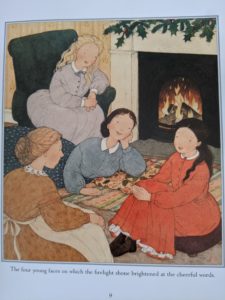I loved Greta Gerwig’s movie, its vibrant sister interaction, superb ensemble acting. It made me cry. I adored Jo because she was me, insisting I’d never marry, never have children, was going to be a writer. Seeing the film inspired me to reread the novel I’d loved at eleven. Much was tedious or unbearably saccharine to me now, but two aspects fascinated me: how writer-director Gerwig transformed this story in film and how Alcott characterized Jo in writing.
Jo won’t forgive Amy for burning the book Jo’s been writing. No computers, you know. Typewriters weren’t in common use until the mid-1880s. Jo’s one hand-written copy was all there was. If Amy’d been my sister, she could wait till hell freezes over. Alcott likewise wrote her books by hand, in cursive, using pen and ink.
After Amy falls through thin ice, Jo blames herself for having been too angry to warn her. She helps rescue her little sister but is anguished by her inability to control her temper. Mother admits to a similar problem. Jo says, “Why, you are never angry!” In the novel, Mother goes on at some length about trying to cure her temper, having learned not to show it, how it took forty years to get this far. For the film, Gerwig lifts one strong line from that paragraph. When Jo exclaims, “Why, you are never angry!” Mother simply replies, “I am angry nearly every day of my life.”
In long Pilgrim’s Progress moralizing sections, I can hear Alcott thinking that her publisher wanted instructive examples of right behavior for girls. Most of that wisely doesn’t make it into the film. Likewise the blow-by-blow of a play the girls put on. (No TV, people!) Gerwig roots the story in its era, shows how young people amused themselves with a glance at a funny scene and done. Ten pages distilled down to a few minutes.
Gerwig’s astute editing transformed this story into something palatable for our times, sliced this book and its Volume 2, Good Wives, into a time-shifting modular structure that rivets attention. She managed a kind of translation, keeping the essence of the original while couching it in a format we can understand. I’ve never said I liked a film better than the book before. I’m saying it now. I’ve admired Gerwig since “Francis Ha” and “Lady Bird.” This film is another triumph and she damn well should have had an Oscar nomination for it.
My second point arose while rereading the novel. Alcott doesn’t use the term, but “tomboy” was applied to girls who acted like boys in the 1880s and was applied to her. In my 1950s childhood, I was dubbed a tomboy for my penchant for climbing trees, collecting snakes, and being uninterested in dolls or the color pink. “Tomboy” wasn’t pejorative, just explained a nontraditional girl. The label went through permutations over time, eventually became an identity for queer girls, although plenty of tomboys turn out not to be queer. Now, “tomboy” happily appears to be falling out of use.
None of the LGBTQ terms we use were available to Alcott’s generation. Euphemisms were all they had. “Gay” meant happy, carefree. “Homosexual” first appeared in the 1890s. “Lesbian” debuted in a medical book around the same time. The acts implied by such labels were illegal and sinful. If she’d had the vocabulary, Alcott wouldn’t have gone there. Yet she goes quite far with what she does have:
Jo puts her hands in her apron pockets and whistles. Her sister says, “Don’t, Jo. It’s so boyish.” Jo retorts, “That’s why I do it.” In the plays they put on, Jo acts “male parts to her heart’s content.” She is clumsy, spills or breaks things, stands too near the fire and scorches the hem of her dress, is said to have “one beauty,” her long hair, which she sacrifices to give her mother money. Alcott’s alter ego, Jo declares she’s never marrying, often says she’ll deal with things “like a man.” The film doesn’t reiterate these points as much as Alcott does. Saoirse Ronan is hardly the plain girl Alcott describes, however boyishly she behaves. The ending Gerwig gives is true: Alcott resisted marrying off Jo, but her publisher insisted on it. Alcott herself never married.
Louisa May Alcott wrote Little Women because her publisher asked her to write a story for little girls. Writing and publishing for over thirty years, she also had her own childhood memories to draw on. She completed Little Women in ten weeks, sometimes forgetting to eat or sleep. Alcott made a living from her writing, worked for the abolition of slavery and women’s rights and served as a nurse during the Civil War.
Little Women ends with Jo publishing her first stories in the local paper, Meg and Brooke falling in love, and father—absent the entire novel—finally recovered enough to come home. The book was wildly popular and Alcott quickly wrote Good Wives, from which Gerwig gathered the rest of her film. Girls had written to Alcott clamoring to know who the sisters married, as if that were all that mattered. It sometimes seems as if, for girls, that’s still the case.


Thanks for this review, Pat. It’s interesting to hear a writers take on the transition from book to film. I will reread it now myself. My only issue with the film was how pretty and well dressed the girls were, when they were supposed to be impoverished. And to me, they all looked to be about the same age. But the scope of the story and the writing were spot on.
Quite a good criticism of the film, Deb. Like the way someone truly “plain” could not have been cast as Jo. But don’t say I didn’t warn you: large portions of the book are so sweet they made my teeth ache and I couldn’t read them.
Thanks so much for this, review of both film and book, with that always curious mind of yours. I had not planned to see the film, thinking I could not sit through one more version of LW. You’ve changed my mind.
I’ve liked Gerwig’s work for a while and think the success of this film was in the way she combined the two volumes, Little Women and Good Wives. Also, lush cinematography.
I loved the movie too and I remember enjoying the book as a kid, but based on the women in my life, a granddaughter and sister included, I happily don’t agree with your last sentence.
I also know young women for whom marriage does not seem to be the main goal of life, Barbara, but as part of my research for this piece, in comments on sites dedicated to the film and book, I read any number of women going on about who should have married who, how Laurie was a perfect match for Jo, and it made me think nothing has changed for some females of the species at least.
Wonderful reflections on our shared experience of the film, Pat! Thank you. Apropos female obsession with marriage: which are those societies that offered a livelihood and financial security to women, or relieved them from the necessity of procreation? Little wonder it has so much weight in our imaginations! Perhaps progress we have made towards equality along with nonbinary gender roles will get us to the point that these ‘choices’ occur to us more readily.
And I kept thinking about putting in your comment on Phil & I reacting to the bookbinding moment in the film, but it didn’t fit, darn it. I hope you’re right about the future, but right now it seems even Roe V. Wade is in danger. And we’re still a country that doesn’t believe a woman can win the Presidency, even though Hillary Clinton already did. Thank you, my dear, and it was a pleasure seeing that with you!
I was tutoring a middle school student this week who was reading To Kill A Mockingbird for class, and he thought Scout was a boy – to the point where he was arguing with me about it. At some point I said “tomboy” (which immediately felt wrong, but I think is just something in neural connect with the book) and the kid I was tutoring had never heard that word before. It’s definitely falling out of use!
Adam, good support for that theory about “tomboy.” I came across the idea that it was fading in my research into when all these terms came into use.
Hey, Pat, thanks for the review. Sounds like a good movie. Gerri and I will have to catch it when we can. Gerri, of course, read the book, but being a boy in the early fifties, no one ever recommended it to me. In any case I was busy bugging the woman in charge of the bookmobile for new Freddy the Pig books, then the Hardy Boys, and then whatever science fiction I could get my hands on.
I can see you reading the Hardy Boys! Speaking of science fiction, my latest great find is The Broken Earth Trilogy by N. K. Jemisin. All three volumes won the Hugo for the year they were published, a first.
Hi Pat, as a sister tomboy I shared similar 1950s childhood except as an urban tomboy I preferred playing ball games and scampering around the ‘hood keeping up with the boys until age 12, then I went to Juilliard and studied piano :-).
I agree with yours and many of the comments, but I do think this third version could have been more innovative and interesting if Gerwig had incorporated more of the “real” life of May Alcott into the texture of the story-telling, a less romanticized version. After the first three versions, we needed something more “subversive” 🙂
I agree, Suzanne Jill Levine! Once I researched Alcott’s life, even just skimming the surface, I found it much more provocative. Thanks for commenting!